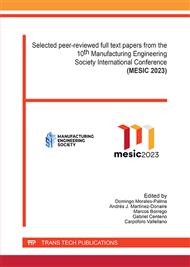[1]
Hofmann, E. and Rüsch, M. "Industry 4.0 and the Current Status as well as Future Prospects on Logistics." Computers in Industry 89 (2017): 23-34.
DOI: 10.1016/j.compind.2017.04.002
Google Scholar
[2]
Taeho Park, Hyuck Moo Kwon, Sung-Hoon Hong. "The optimum common process mean and screening limits for a production process with multiple products." Elsevier 60 (2011): 158-163.
DOI: 10.1016/j.cie.2010.10.013
Google Scholar
[3]
José M. Merigó, Montserrat Casanovas. "Decision-making with distance measures and induced aggregation operators." Computers & Industrial Engineering 60 (2011): 66-76.
DOI: 10.1016/j.cie.2010.09.017
Google Scholar
[4]
Zhang, Zhi XuChuan WangXin WangJiaHai. "Robotics for control strategy optimization and simulation in automatic cigarette sorter." Computers and Electrical Engineering journal 99 (2022).
DOI: 10.1016/j.compeleceng.2022.107801
Google Scholar
[5]
Y.P. Tsang, T. Yang, Z.S. Chen, C.H.Wu, K.H. Tan. "How is extended reality bridging human and cyberphysical systems in the IoT-empowered logistics and supply chain management?" (2022).
DOI: 10.1016/j.iot.2022.100623
Google Scholar
[6]
Tianhui Wanga, Manjeet Singhb, Gürsel Süera. "Evaluation of Alternative Labor Levels to Minimize Average Flowtime at Distribution Centers." Procedia Manufacturing 39.25th International Conference on Production Research Manufacturing Innovation: Cyber Physical Manufacturing (2019): 1482–1492.
DOI: 10.1016/j.promfg.2020.01.300
Google Scholar
[7]
Andrea Ferrari, Giovanni Zene, Carlo Rafaele, Antoni Carlin. "A Roadmap towards an Automated Warehouse Digital Twin: current implementations and future developments." Science Direct 55.10 (2022): 1899-1905.
DOI: 10.1016/j.ifacol.2022.09.676
Google Scholar
[8]
Global parcel shipping volume between 2013 and 2026. (2020)<https://www.statista.com/ statistics/1139910/parcel-shipping-volume-worldwide.>.
Google Scholar
[9]
Carlier, Mathilde. Spanish courier, express, and parcel shipments 2013-20. NY: Statista, (2023).
Google Scholar
[10]
Placek, Martin. Parcel shipping volume worldwide 2013-2027. NY: Statista, (2022).
Google Scholar
[11]
Sara Ali, Antonio Galrao Ramos, Maria Antonia Carravilla, José Fernando, OliveiraS. "On-line three-dimensional packing problems: A review of off-line and on-line solution approaches." Computers & Industrial Engineering 168.108122 (2022).
DOI: 10.1016/j.cie.2022.108122
Google Scholar
[12]
Barreto, L. and A. and Pereira, T. Amaral. "Industry 4.0 Implications in Logistics: An Overview". Procedia Manufacturing, 13 (2017): 1245-1252.
DOI: 10.1016/j.promfg.2017.09.045
Google Scholar
[13]
Winkelhaus, S. and Grosse, E.H. "Logistics 4.0: A Systematic Review Towards a New Logistics System." International Journal of Production Research (2019): 1-26, .
DOI: 10.1080/00207543.2019.1612964
Google Scholar
[14]
Chiara Cimini1, Alexandra Lagorio, David Romero, Sergio Cavalieri, Johan Stahre. "Smart Logistics and The Logistics Operator 4.0." Science Direct 53.2 (2020): 10615–10620.
DOI: 10.1016/j.ifacol.2020.12.2818
Google Scholar
[15]
Gong, Y. and De Koster, R. "A Polling-Based Dynamic Order Picking System for Online Retailers." IIE Transactions, 40.11 (2008): 1070-1082.
DOI: 10.1080/07408170802167670
Google Scholar
[16]
Shuya Zhong, Vaggelis Giannikas, Jorge Marino, Duncan McFarlane. "Evaluating the benefits of picking and packing planning integration in e-commerce warehouses." European Journal of Operational Research 301 (2022): 67-81.
DOI: 10.1016/j.ejor.2021.09.031
Google Scholar
[17]
William de Paula Ferreira, Fabiano Armellini, Luis Antonio de Santa-Eulalia, Claudia Rebolledo. "Modelling and Simulation in Industry 4.0." Artificial Intelligence in Industry 4.0. A Collection of Innovative Research Case-studies that are Reworking the Way We Look at Industry 4.0 Thanks to Artificial Intelligence. Vol. 928. Springer, (2021). 57-72.
DOI: 10.1007/978-3-030-61045-6_5
Google Scholar
[18]
Lili Zhang, Zhengfeng Li, Yang Yang, Menghan Cu. "Human error unplanned downtime inferring and job-operator matching based on inverse optimal value method." Computers & Industrial Engineering 149.106840 (2019).
DOI: 10.1016/j.cie.2020.106840
Google Scholar
[19]
Adriana Florescu, Sorin Adrián Barabas. "Modeling and Simulation of a Flexible Manufacturing System a Basic Component of Industry 4.0." Applied Science 10(22).8300 (2020).
DOI: 10.3390/app10228300
Google Scholar
[20]
Rie Gaku, David T. Sturrok, Soemon Takakuwa. "Simulation and the Fourth Industrial Revolution." CORE (2019): 69-79.
Google Scholar
[21]
Patrik Grznár, Milan Gregor, Martin Krajˇcoviˇ, Štefan Mozol, Marek Schickerle, Vladimír Vavrík, Lukáš Durica, Martin Marschall, Tomáš Bielik. "Modeling and Simulation of Processes in a Factory of the Future." Applied Science 10.4503 (2020): 1-24.
DOI: 10.3390/app10134503
Google Scholar
[22]
Gola, A. and Ł Wiechetek. "Modelling and simulation of production flow in job-shop production system with enterprise dynamics software." Applied Science 13 (2017).
DOI: 10.35784/acs-2017-32
Google Scholar
[23]
Marius Mihaluta, Patrick Martin, Jean-Yves Dantan. "Manufacturing Process Modeling and Simulation." Hal Open Science 7 (2008).
Google Scholar
[24]
Jiří Gregor, Jiří Kropáč, Martin Pavlas. "Sorting Line Modelling as an Integral Part of Complex Tools for Decision-making in Waste Management." CHEMICAL ENGINEERING TRANSACTIONS 70 (2018).
Google Scholar
[25]
Yeongmin YUN, Junjae CHAE. "Simulation Analysis for in-Line Sorting-and-Washing of Reusable Pallets: A Case Study ." (2022): 1848-6339 .
DOI: 10.17559/tv-20200701044934
Google Scholar



